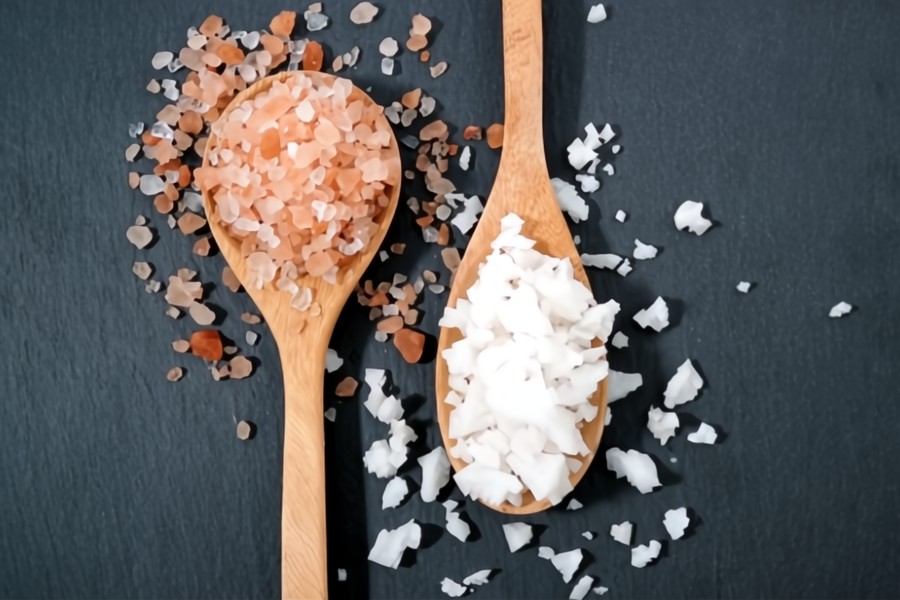
What are salts? If we asked this question to different people, do you know what they answer?
They said white crystals used in cooking to leave its characteristic salty taste refer to salt. That’s true, salts are vital ingredients of every recipe even low-cholesterol food such as salad or all-time favorite popcorn. Do you think all salts are alike? Well, you might not know that there are numerous types of salt. All have distinct taste, crystal sizes, and appearance.
Today, we will dish out two very different types of salts so you can use them properly without getting confused. Check out this article to learn how to use Kosher Salt vs. Himalayan salt along with their benefits.
What is Himalayan Salt?
Pink Himalayan salt is obtained from Khwera salt mines in Punjab, Pakistan. Its pink hue has played a role, in making Himalayan pink salt widely popular. In addition to color differences, its unprocessed and organic nature makes it a popular food choice.
It is known to have 84 different trace minerals, including iron, magnesium, and other minerals reported as health boosters. No intricate process is used to infuse iodine in pink Himalayan salt. offers a mild flavor that is slightly sweeter, than regular table salt.
Step into a world of flavor and health benefits with Himalayan pink salt, Visit Ittefaq Salt – a Himalayan salt supplier.
Uses Of Himalayan Salt:
Himalayan salt is one of its types, helping people of all ages to make their daily chores easier. Here, are some practical uses of Himalayan Salt:
- It’s the main ingredient of every culinary experience as it adds wholesome flavor to several dishes.
- The pink crystals of the Himalayan salt make it an ideal choice for finishing salt on salad, stews, pasta, or cooked food.
- Himalayan salt blocks are heated on a high flame and used for cooking, grilling, and serving food.
- Himalayan pink salt is also incorporated into wellness practices. Salt lamps, Himalayan salt scrubs, and inhalers are some of the commercially available salt products.
What is Kosher salt?
Kosher salt, another popular salt type, is commonly used in cooking. It gets its name Kosher because of its application in the Koshering process (typically used to draw blood out of the meat).
Kosher salt typically has coarse grains compared to table salt, which makes it useful for applications where a more textured salt is desired. Commonly it finds its applications in seasoning meat or rimming cocktails glasses. It is less dense and hence used in large quality to add the same level of saltiness or desired aroma as compared to table salt.
The larger grain size of kosher salt is appreciated due to its ability to absorb more water or blood in the koshering process. However, the same properties make them less soluble in water than table salt. People love to add a pinch of this salt to enhance the flavor of natural fruits and seasonal dishes.
Uses of Kosher salt:
Kosher salt is unrefined and does not contain any seawater impurities as harvested on land. Its unique subtle flavor makes it a secret ingredient of almost every zesty food. Despite baking, you can use it in any traditional, Chinese, or Italian food recipe. Kosher flake salt finds its role in seasoning. Fine kosher salt adds goodness of salt to your daily healthcare routine. You can use coarse kosher salt for other household processes such as pickling and brining, and cleaning meats, shelves, and other areas as disinfectants.
Himalayan salt vs Kosher salt
Kosher Salt Vs. Pink Saltboth have lots ofoverarching points. The most prominent one is they are essential ingredients of every large family feast to the routine cooking experience. However, based on the composition, size, texture, and color, the Himalayan pink salt and kosher salt differences are notable.
- It is mainly composed of sodium chloride, with larger, irregular crystals. It usually doesn’t have any ingredients or anti-caking substances. On the other hand, pink salt is extracted from sea salt deposits and its pink color comes from trace minerals such, as iron oxide. In addition to sodium chloride, it also has quantities of minerals like calcium, potassium, and magnesium.
- Kosher salt is famous for its taste and it often lacks minerals. Himalayan salt’s coarse texture makes it ideal for seasoning food during cooking. It has a milder, subtle salty flavor. Its mineral content can impart subtle flavor nuances.
- Kosher salt has a texture and larger crystals, than table salt, which makes it simple to pinch and sprinkle onto food for seasoning. Pink salt is available, in textures ranging from fine to coarse. It’s often used as a finishing salt for its visual appeal and can add a crunchy texture to dishes.
- Kosher salt appears white while the Himalayan Pink salt is known for its distinguishable pink hues.
Takeaways:
Simply put,Kosher Salt vs. Himalayan salt is an interesting debate for all professional chefs and housewives. Stop pondering which one is better. With the same general use of seasoning and balancing the flavor of other spices, you can choose one based on your individual preferences. However, some differences like changes in color, grain size, and profile make one type preferable over the other. To use Himalayan pink or even rock salt as kosher salt alternatives, you must know the key differences between them. The best results of any type of salt of your choice depend on its purity and quality.
Become a Harlem Insider!
By submitting this form, you are consenting to receive marketing emails from: Harlem World Magazine, 2521 1/2 west 42nd street, Los Angeles, CA, 90008, https://www.harlemworldmagazine.com. You can revoke your consent to receive emails at any time by using the SafeUnsubscribe® link, found at the bottom of every email. Emails are serviced by Constant Contact







